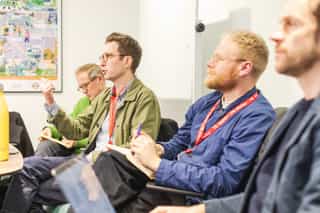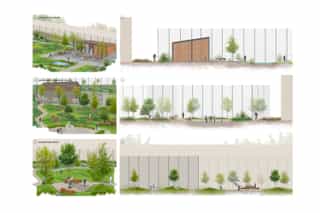Power of Networks
InsightsOn the back of a recent ING Roundtable discussion, centering on the power of networks across Greater Manchester (GM), I wanted to assess whether there was a correlation between network strength and social, economic and environmental performance.

Principally, given the importance of and reliance on networks to deliver the commitments of the Greater Manchester Strategy 2021-2031, and its bold mission:
“Greater Manchester is a great place to grow up, get on and grow old; a great place to invest, do business, visit and study for Good Lives for All - Greener, Fairer, More Prosperous - driven by opportunities in all localities.”
As an urbanist working alongside many Local Authorities over the last 30 years, I am fully behind the thrust of the GM strategy. Experience shows, cities work best when their orbiting urban networks are fully interconnected to incorporate transportation, communication and social networks. In turn, they deliver liveable and sustainable places to live and work in for future generations.
My research indicated that existing economic networks are powerful within the GM. They have catapulted Manchester to be the leading City outside of London for property investment; funding models such as institutional Built to Rent, influencing the form, scale and development pattern of the city’s core.
These powerful economic networks have also begun to positively influence the outlying boroughs of GM. This is evident in Planit’s recent Town Centre regeneration work across the region from Prestwich to Ashton-under-Lyne and Wigan to Stockport, which amount to over £0.5 billion worth of investment.
However, GM’s performance against environmental and social indicators lag behind that of other Combined Authorities. Whilst extensive networks exist to support the achievement of the strategy’s goals, they lack the same power and strength demonstrated by GM’s economic networks. Further, the same economic networks have had a detrimental impact on the biodiversity ecosystems which we rely on to live healthy lives and are in direct conflict with the strategy’s vision and goals. This was highlighted in the recent documentary, ‘Paul Whithouse: Our Troubled Rivers’, revealing that the River Tame was shown to have the highest concentration of microplastic in the world.
If GM is going to deliver on its commitments laid out in its 2021 - 2031 Strategy, it will need to ensure that the network’s goals are more holistic and aligned; their strength and power are more evenly balanced, and they are far more interconnected and interdependent with nature.
The current Strategic level framework, Places for Everyone (PFE), has been strongly influenced by development/economic networks which have laid the foundation for more integrated transport and environmental networks. It has yet to harness the power of more holistic network considerations – many of which are bottom up in nature.
Smart City and Cultural Networks have become powerful and are moving out from the City to other GM locations. Such network innovations are creating a more interconnected service delivery. One city Network is a single network infrastructure across several public sector organisations and will make network services more efficient, secure and flexible. It can also scale-up service delivery innovation as seen in Wigan Council’s pioneering "Community Deal" approach. Its central aim has been to empower local communities by shifting the focus from a traditional top-down delivery of public services to a more collaborative and community-centred bottom-up model.
The challenge for Councils is to understand that the objectives of the strategy lie in the models and systems which underpin their networks. Specifically, where there they are disconnected from the financial system. As a consequence, the networks lack the capital to drive the necessary change.
The solution here is to secure and harness alternative sources of capital. Social capitalis is derived from social and community networks (Commoning Networks) and inherent in the Circular Economy. Planit’s Standard Practice studio have been working on such a project over the last 3-years, PLANT at Noma, enabling city communities in the heart of Manchester city centre the opportunity to connect through city gardening. To read more about the project and value it has created click here.
Placing communities at the heart of both formulating and delivering the solutions is key to ensuring each borough plays a unique place-based function. It strengthens the region as a whole and makes the most of its spatial configuration, comprising a ‘City surrounded by towns’.
If GM were to adopt a more holistic approach to its economic, social and environmental systems and networks, and utilise its existing pioneering innovation - such as Natural Capital Accounting where the full ecosystem services of environmental systems are valued - it will ensure a deeper understanding of trade-offs and impacts that occur between them. In turn, it can establish interconnected goals and formulate solutions which leverage synergies across the systems. Network manipulation is achieved.
There is evidence to show that all networks can be successfully interconnected through pioneering projects. Planit’s recent work, Northern Roots in GM’s Oldham, is a prime example of connected networks and creating a super node between networks. Northern Roots, the UK’s largest urban farm and eco-park set on 160 acres of under-used green space, is now being developed for and with local communities at its heart. The new urban green space will include a wide mix of on-site activities, facilities, energy generation and business opportunities that will benefit people, planet and place for future generations. Hyperlink to any more information on Northern Roots.
To summarise, in order to achieve greater social, economic and environmental performance in Greater Manchester, each network will require more consideration and greater awareness of how it interplays.
The GM’s existing dashboard will enable it to track progress against the objectives laid out in the strategy. However, in order to move the dial towards a truly interconnected city network scenario, more interconnected measurement tools are required. This type of systems’ thinking is being developed in cities and city regions such as Amsterdam, Portland and Philadelphia using ‘The Doughnut City Portrait’ methodology – developed from the work of economist Kate Raworth. Planit is currently adapting the tool to deliver its mission to create Regenerative Places.
Planit Key Takeaways - Opportunities, Recommendations and Next Steps...
- Link networks through flexible local plans - employ holistic tools to track progress and create synergies - utilise Smart City Networks.
- Unleash the power of the Commons’ networks - link them with flexible planning frameworks from the bottom up to deliver locally place-based approaches.
- Build on successful networks and ensure the value is maximised throughout the region.
- Create nodes to link the networks but vary them according to place - Urban Acupuncture is key.
- Build on Natural Capital Accounting tools - link to new development and then build the gaps in the networks.
Related Thoughts

Climate Emergency and Public Realm Carbon Assessment Roundtable

Climate Emergency and Public Realm Carbon Assessment Roundtable

Restorative Prison Landscapes



